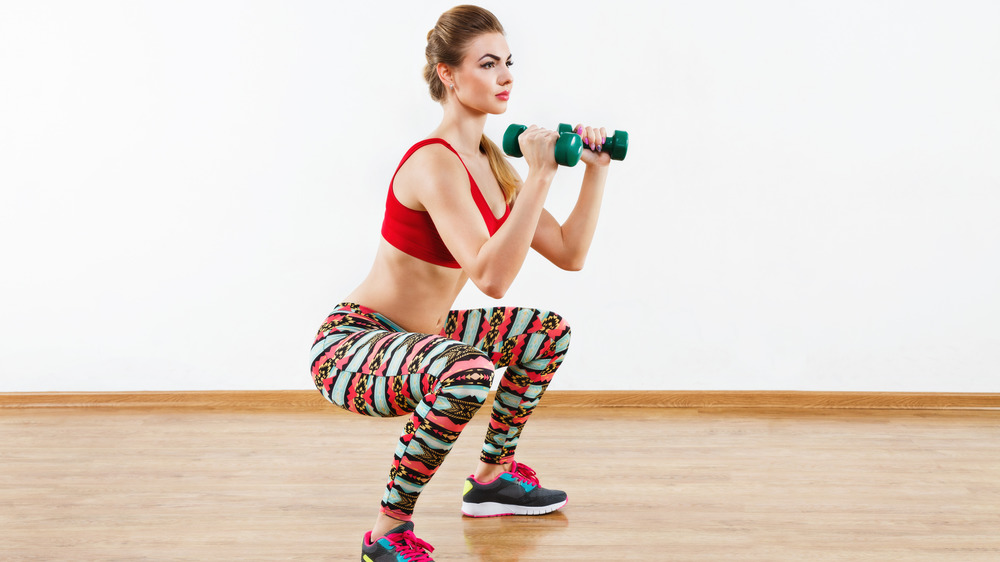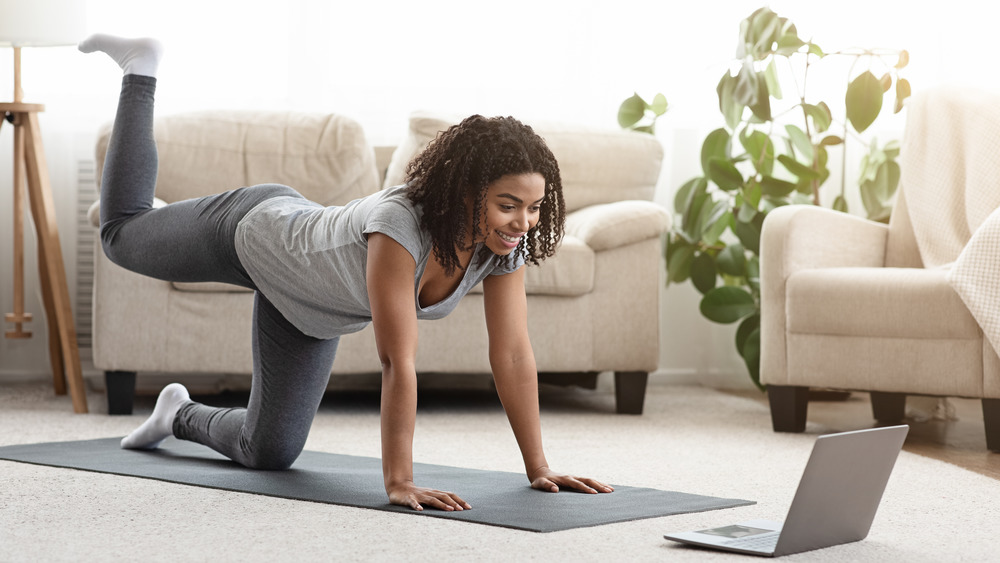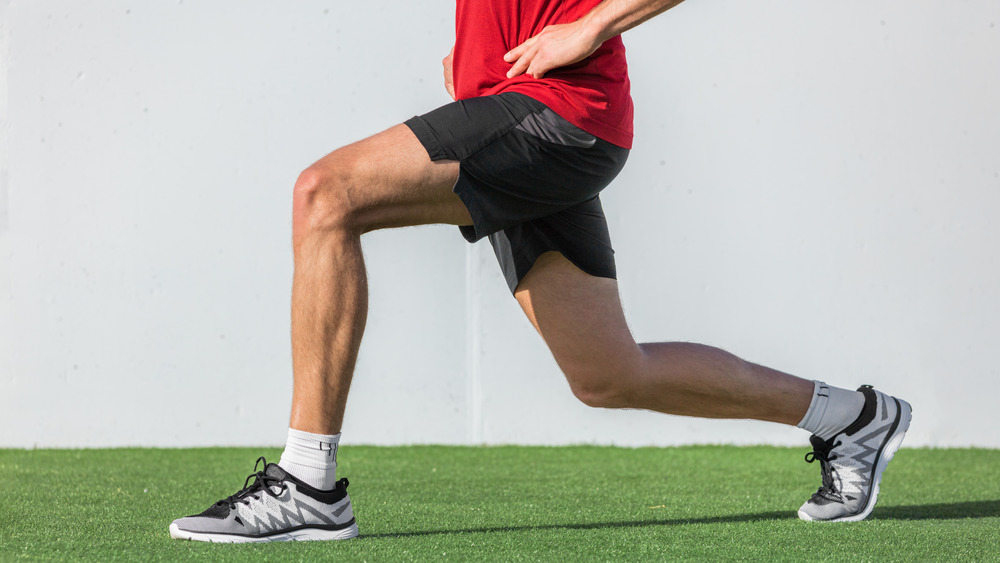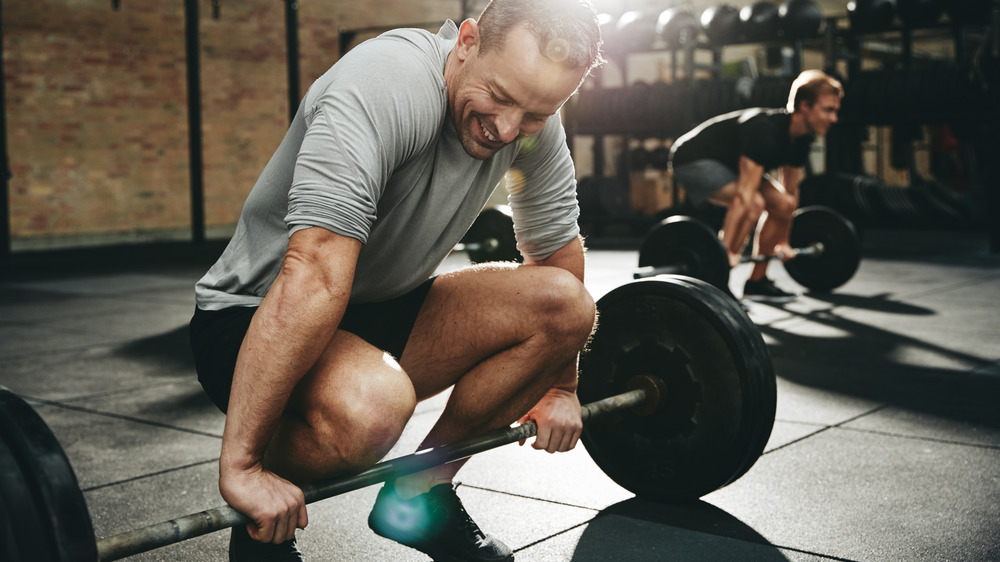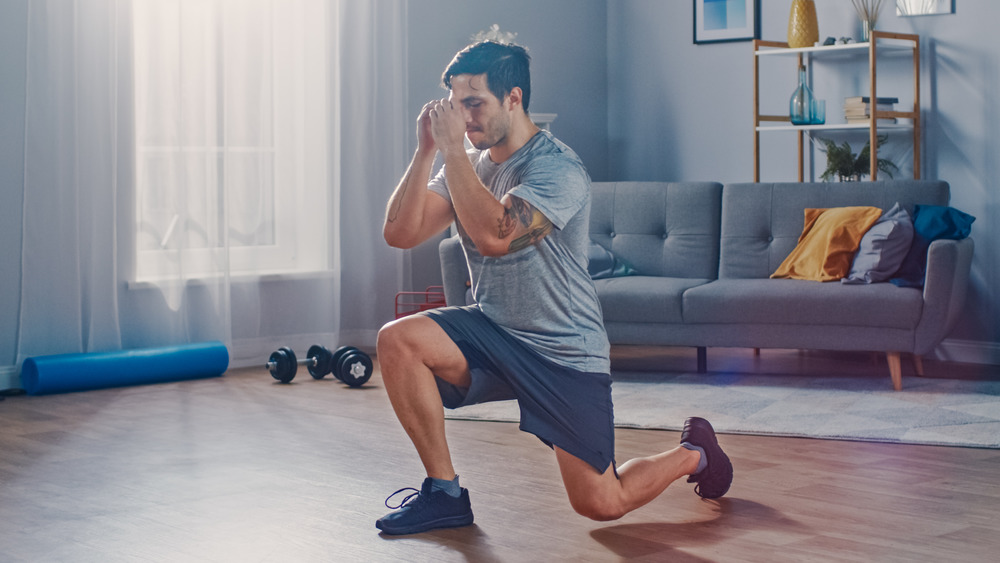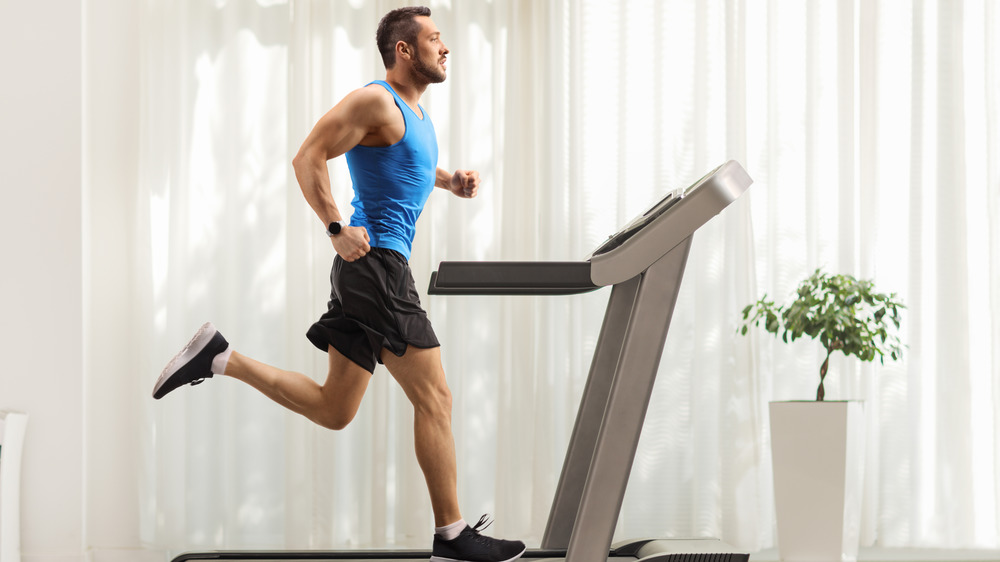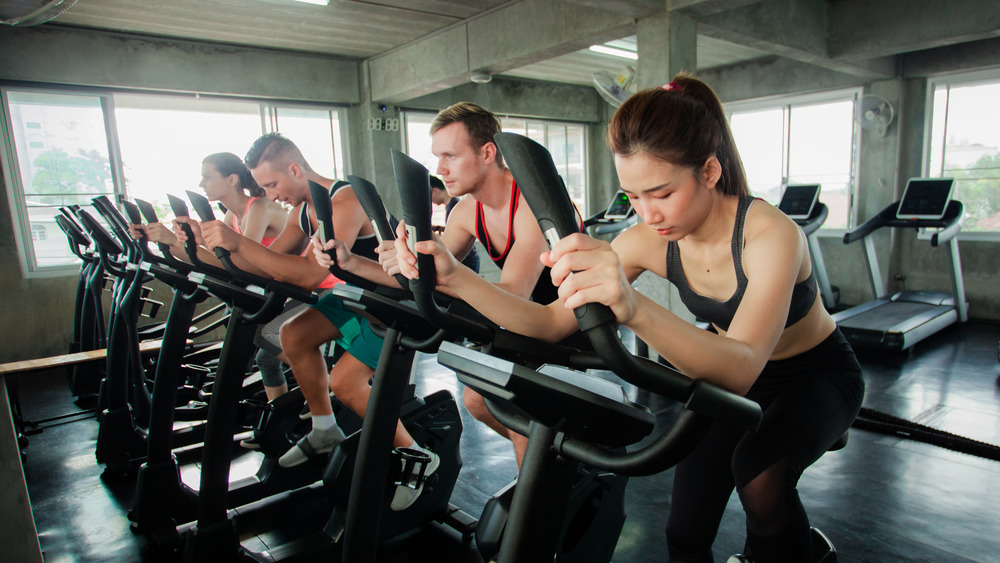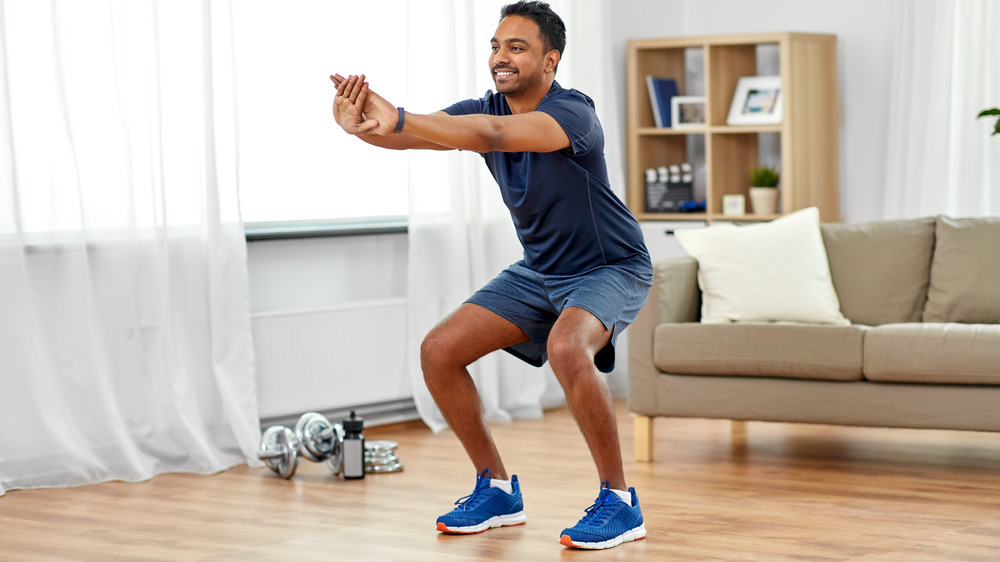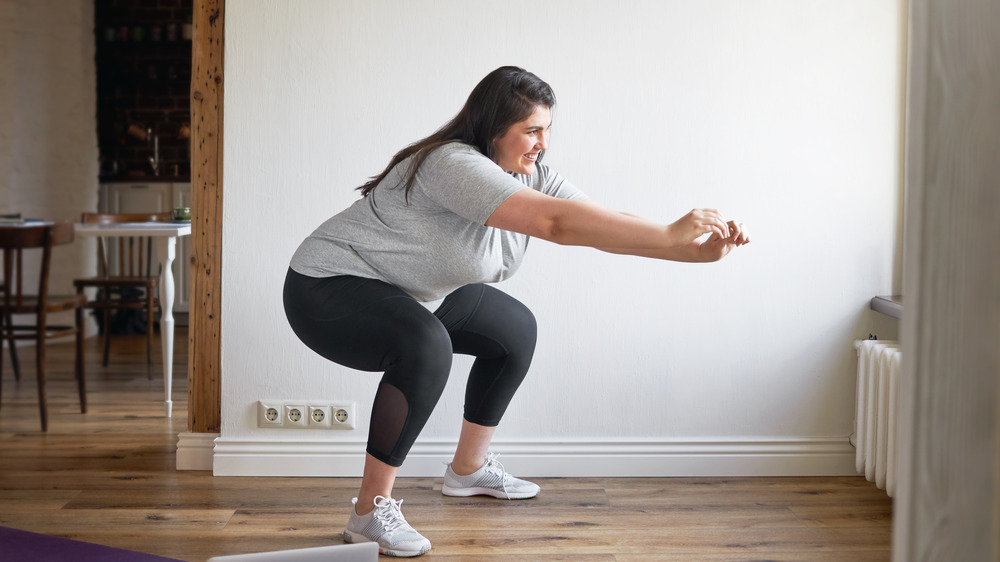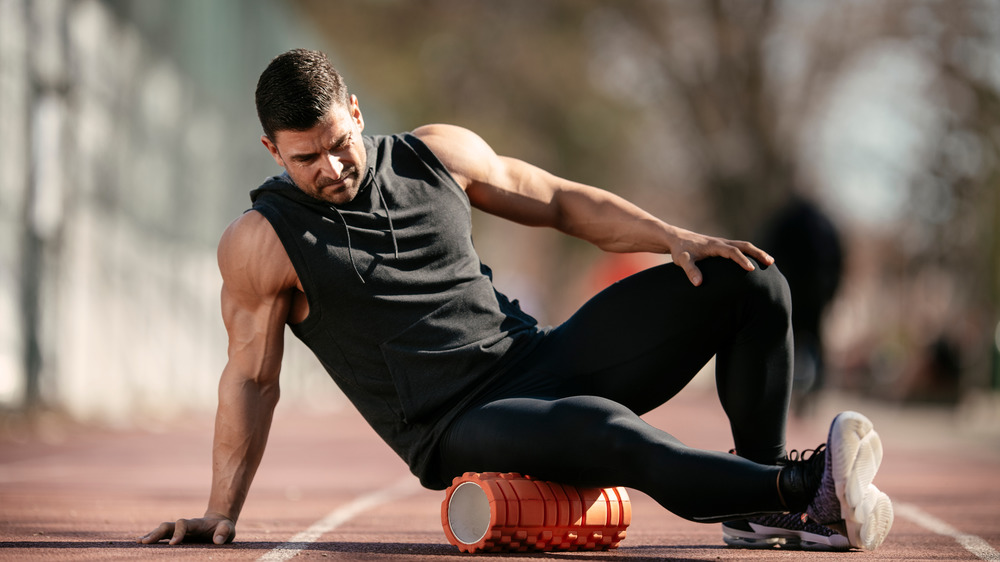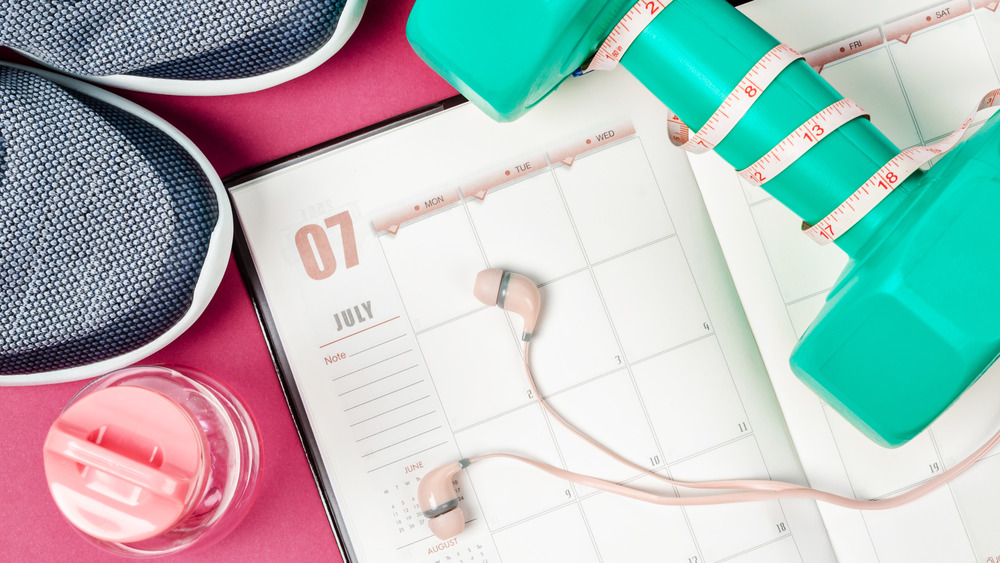If Your Leg Workout Isn't Working, This Is Probably Why
Working out your legs is one of the best things you can do for your metabolism, balance, coordination, agility, and long-term health. You see, the muscles of your legs are some of the largest muscle groups in your body, including your glutes, hamstrings, quads, and calves. Your legs are involved in practically every movement you make, whether you're walking to the mailbox or standing up from a chair. And, of course, whenever you're engaging in athletic endeavors, your legs help propel you in every direction, supporting the activities you love most.
Because muscle is considered a metabolically active tissue (in other words, it burns calories), the more muscle you have — particularly in large muscle groups like the legs — the more calories you'll burn 24 hours a day. However, if you've stopped seeing results from your workouts, it might be time to switch things up. These are the common culprits of a stalled lower-body routine.
You're not lifting enough weight
If your leg workout results have ground to a halt, chances are you need to start adding more weight to your exercises. Essentially, your body doesn't like doing hard things. This sounds counterintuitive, but it's true. When you add a new stressor (like strength training) to your routine, it basically yells, "Hey wait a minute, that was hard!" But then it goes to work adapting and changing to be able to handle the same stressor more easily the next time it's encountered.
As Albert Matheny, a registered dietitian and strength coach, told Women's Health, "Your body will not build muscle until it is stressed." And because your lower body boasts large muscle groups, you have to add more stress (like weights) as it adapts to your strength training routine in order to keep seeing results.
If you find that knocking out a set of 12 repetitions of squats feels a lot easier than it once did, that's a clear sign you need to add more weight. When performing sets of eight to 12 repetitions, you want the last one or two repetitions of each set to feel difficult (but not impossible) to complete with good form.
You're focusing too much on isolation exercises
Look, there's nothing wrong with training your inner thighs as part of your leg routine, but you shouldn't just be focusing on your inner thighs. And, really, knocking out a couple sets of clam shells or inner thigh leg lifts is great, but if exercises like these make up the bulk of your workout, you're unlikely to see the results you're hoping for.
There are several problems with focusing on these movements. First, they tend to isolate a single, smaller muscle group rather than maximizing the use of multiple, large muscle groups. This means they're not as metabolically stimulating (they don't burn as many calories), and won't garner the same strength results as compound exercises (like squats and deadlifts) that target multiple, large muscle groups.
Plus, as Nick Tumminello, the owner of Performance University in Baltimore, told Shape, "There's nothing remotely like these movements [hip abduction and adduction machines] in life." You're better off doing exercises that translate to other daily movements to maximize your results. The best part? As Tumminello explained, compound exercises — like step-ups and lunge variations — also target the smaller "trouble zone" muscles, like those of the inner thighs.
You always follow the same routine
There's something comforting about having a go-to gym routine. You know what you're doing. You know what machines or weights you're going to use and how to do the exercises. You know how many sets and reps you're going to complete. You know how long everything takes and that it works with your schedule. There's nothing wrong with settling into a routine; in fact, a steady routine is a great way to develop consistency in a workout. The problem? Failing to mix things up can lead to stagnancy.
According to an article written by Cedric X. Bryant, the president and chief science officer for the American Council on Exercise, the body's muscular systems typically adapts to a workout routine within six to eight weeks. Failing to modify your routine in this time frame can make you "reach a plateau because your body has adapted to the repetitive training stimulus." If you want to keep seeing results, you need to change things up — add more weight, switch up your exercises or the order of your exercises, change up your sets and reps, or add a different style of training to your routine.
You're training too intensely
Going all out at the gym every day is bound to lead to great results, right? Not so fast. As with all things, balance is key. You should go for a happy medium as pushing yourself too hard can make your leg workout results stall. As Justin Robinson, a registered sports dietitian and strength and conditioning coach, wrote for the American Council on Exercise, there's a "tipping point" in the continuum of exercise volume and intensity.
If you pass your tipping point, your exercise routine can start doing more harm than good. This is referred to as overtraining syndrome (OTS), and one of the first signs is decreased performance, or a plateau in performance despite more time logged at the gym (or wherever you get sweaty). So, if after weeks of hitting the gym hard, you realize your results have slowed to a halt and you're also experiencing symptoms like fatigue, moodiness, insomnia, aches, pains, or injuries, then it may be time to back off from your routine. Your body needs time to recover.
You forget to include rest days after a leg workout
What many people fail to realize is that muscle growth doesn't take place during your workout. In fact, what your workout is actually doing is putting stress on your muscles, causing microscopic tears in the muscle fibers. This sounds like a bad thing, but it's this muscle damage that causes your body to say, "Oh! Looks like it's time to rebuild those muscle fibers stronger — we don't want to experience that damage again." And this repairing and rebuilding takes place in the days following a workout, not at the time of the workout.
"Insufficient rest and recovery does not allow for optimal muscle protein synthesis and could lead to an accumulation of energy-producing hormones such as epinephrine and cortisol, which can reduce the ability to generate new muscle tissue," Pete McCall, a certified strength and conditioning coach revealed in an article for the American Council on Exercise. In other words, you need to give your legs a day or two to recover after a tough leg workout. This doesn't mean you need to avoid exercise altogether, but you shouldn't do two tough leg workouts on back to back.
You're only doing cardio
No one's knocking cardio. Cardiovascular exercise is essential for overall health and wellness. Certainly, exercises that target your lower body, like running or cycling, can help develop some strength in your legs. That said, if you're relying solely on cardio to give you the legs you've always dreamed of, it might be time to reconsider your workouts.
If you're doing a lot of cardio without adding strength training to your routine — even if you're doing cardio that targets your legs — you're likely to have a lower level of muscle mass than you would if you added strength work to your workout, strength coach Albert Matheny explained when speaking to Women's Health. The solution is quite simple: Skip or cut back on one or two cardio sessions each week and add at least two leg-focused strength workouts that include compound exercises like squats, lunges, and deadlifts.
You're not doing the right type of cardio
Remember, when it comes to developing muscle mass, you have to push your muscles to the point where they regularly experience microscopic tears in the muscle fibers. Running the same route day after day at roughly the same speed is unlikely to continue garnering this type of stress to your muscular systems as your muscles will adapt and become more efficient.
That said, if you regularly use your cardio routine as an adjunct to strength training, and you push your muscles to the point of fatigue by running hills, stair climbing, adding sprint work, or increasing resistance on a spin bike or other cardio machine, you may be able to maximize your results. If your leg workout hasn't been doing much for you, consider ditching that steady jog through the neighborhood and try high-intensity interval training (HIIT) instead. It'll certainly make your glutes and quads burn.
You're not using a full range of motion
It's pretty simple: When you do an exercise half way, you can hardly expect to see the full results. And that's exactly the case when it comes to your leg workouts. Now, to be clear, there are legitimate reasons why a person may not be able to take an exercise, like a squat or a lunge, through a full range of motion — maybe there's a previous injury or a muscular imbalance that makes the complete exercise painful or unsafe. In these situations, performing an exercise with a limited range of motion is encouraged.
A study published in the Journal of Strength and Conditioning Research in 2012 found that both full and partial range-of-motion exercises could result in improved muscle strength and thickness, but that those performed with a full range of motion may lead to greater overall strength gains. This is because when you take your muscles as far as possible (with good form), you're targeting every fiber in the muscle. The result is greater strength and improved results and performance. If you're not sure if you're using a full range of motion, enlist a trainer to help you out.
You're not using the proper form
The most obvious example of poor form interfering with desired results is with the biceps curl. If you've ever seen someone using their entire body to help swing the weight upward to their shoulders rather than only bending the elbows and isolating the biceps to lift the weight, you've seen this problem in action.
In an article for the National Federation of Professional Trainers, Gerard Casazza, a certified trainer, further broke down this example: "If we're swinging our whole body into the intended biceps curl movement, chances are that our bicep is not getting worked, and you're working more of your shoulder girdles and core." And if you're not targeting your intended muscle groups effectively, you're not going to see the strength gains you're hoping for.
Of course, this applies to all exercises, including those of the lower body. Common examples include hamstring curls and quadriceps extensions, deadlifts, and cleans. And of course, there are often form mistakes associated with squats and lunges. While you may assume that lifting heavier weight, even at the expense of good form, will get you better results, you're really just slowing the process down and opening yourself up to injury.
You're not stretching or foam rolling
Failing to property stretch and recover may not be the biggest reason you stop seeing the results you want from your leg workouts, but it can certainly be a contributing factor. The issue boils down to working your muscles through a full range of motion. When you're able to target the entire muscle by working it from one end to the other, you'll end up experiencing better results.
However, many people have difficulty with flexibility, or muscular imbalances can prevent them from being able to perform exercises through a full range of motion. The International Sports Science Association explained that sedentary people tend to bend at the waist. In doing so, their quads and hip flexors may shorten and their hamstrings and glutes may lengthen. This can result in tight hips and low back pain, both of which can interfere with range of motion.
So, how can you fix this problem? Incorporate flexibility training into your routine. Stretch after your workouts, do yoga or Pilates every week, and incorporate foam rolling into your routine to loosen up tight spots and improve your range of motion over time.
You're hoping for results too soon
Your body is not a microwave. You can't expect your results to "cook" quickly, especially if you've spent months or years without doing much activity. As Thrive personal trainer Sean De Wispelaere told Prevention, "People think they can go to the gym for two weeks and see all the muscles in their legs, but it doesn't work like that."
For one thing, building muscle takes time. Secondly, burning excess fat (an entirely separate process as fat doesn't "turn into" muscle or vice versa) takes time. And it's the combination of the two — increased muscle mass and decreased fat mass, or a total change in body composition — that makes your body look leaner.
De Wispelaere explained that you'll need to wait at least four to six weeks to start seeing results if you're working your legs three times a week. And even then, results take time and you have to be consistent. It may be two to three months before your program visibly pays off. In the meantime, pay attention to the other benefits of your workouts, like how strong you're getting and how exercise makes you feel.
You're not eating enough
You know you need to manage your food intake if you want to lose body fat. Regardless of your workout routine, if you consistently consume too many calories you're not going to see the results you're aiming for. But surprisingly, the opposite is true, too. If you fail to consume enough calories, your results can bottom out. This is because your body needs high-quality energy (food) to build new muscle fibers and keep your metabolism ticking. This is especially true if you're trying to build more muscle to sculpt the glutes of your dreams.
The International Sports Science Association put it this way: "Your body can't create that new muscle tissue out of nothing. To make gains you have to have the right nutrients in your body to construct muscle. Furthermore, if you aren't eating right you won't have the energy to do the workouts that lead to muscle gain."
If you've cut back on calories to lose weight but you're not seeing the results you want, it may be time to add more calories to your diet. Talk with a sports nutritionist to determine how much you should be eating.
You're skimping on the protein
It's not just how much you eat that makes a difference in your workout results, but what you eat. A diet that supports muscle building consists of high-quality sources of carbs, fats, and proteins, with a focus on protein intake. To be clear, this doesn't mean that protein should be the majority of what you eat. In fact, protein should only make up roughly 15 to 25 percent of your daily intake, but you need to be sure you're eating enough.
As stated by the International Sports Science Association, "Muscle tissue is made up largely of proteins, which is why this macronutrient is essential." It's also important to "look closely at actual protein intake and make adjustments if necessary." If you're working out regularly, aim to consume roughly 1.2 to 1.7 grams of protein per kilogram body weight. For a person who weighs 150 pounds, this translates to 95 to 136 grams of protein every day.
If you track your diet and determine you're not consuming enough, bump up your intake with eggs, lean beef, or chicken, and aim to consume a serving immediately after your workout when your muscles are in peak recovery mode.
You're not getting enough sleep
What you do outside of the gym can make a big impact on the results you get from your gym time. Not only does your body need rest days and proper food intake to build stronger muscles, but you need to make sure you're getting enough sleep. The hours you spend logging z's are the hours that your body goes into recovery overdrive. According to an article for the American Council on Exercise written by personal trainer Pete McCall, sleep could be one of the most important parts of a total wellness program.
McCall explained, writing, "Your body produces most of the hormones needed for tissue repair during the deep REM cycles of sleep. If you are planning a high-intensity workout, it is important that you have the ability to get a full night's sleep to allow the endocrine system, which produces hormones, to play its role in the recovery process." If your workout results have plateaued and you've been burning the candle at both ends, it may be time to improve your sleep schedule. Aim to get at least seven to eight hours of sleep per night for optimal recovery results.


